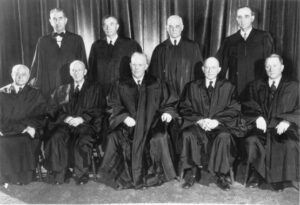
Brown v. Board of Education was a landmark Supreme Court case in 1952 that addressed the question of whether the segregation of children in public schools solely on the basis of race deprived minority children of the equal protection of the laws guaranteed by the Fourteenth Amendment. In a unanimous decision, the Court ruled that racial segregation in public education has a detrimental effect on minority children because it is interpreted as a sign of inferiority, overturning the long-held “separate but equal” doctrine as unconstitutional. Separate but equal is inherently unequal in the context of public education.
The Brown v. Board of Education decision was based on the equal protection clause of the Fourteenth Amendment. The Fourteenth Amendment contains the following clauses: 1) the privileges and immunities clause, 2) the due process clause, 3) the equal protection clause, and 4) the citizenship clause. These clauses are all contained in the first section of the Fourteenth Amendment, which is the most well known portion of the amendment. It states:
“All persons born or naturalized in the United States, and subject to the jurisdiction thereof, are citizens of the United States and of the state wherein they reside. No state shall make or enforce any law which shall abridge the privileges or immunities of citizens of the United States; nor shall any state deprive any person of life, liberty, or property, without due process of law; nor deny to any person within its jurisdiction the equal protection of the laws.”
Prior to Brown, the Court interpreted the equal protection clause under rational basis test under Plessy v. Ferguson. Under this approach, the Court ruled that segregation was not discrimination and upheld the “separate but equal” doctrine as valid. However, when it came to the very famous Brown v. Board of Education case, the Court took a very different approach.
The court applied a strict scrutiny test in deciding the Brown case. Under a strict scrutiny approach, a law must be: 1) pursuing a compelling government interest and 2) be narrowly tailored to achieve that interest. This is the most stringent test that the court uses to interpret law, and allowed them to achieve the ruling that segregation was unconstitutional.
The Brown ruling was extremely controversial for its time. It took several years for the Brown ruling to become a reality, especially in public schools in the southern portion of the United States.
Back to Crime Library
|
|
|
